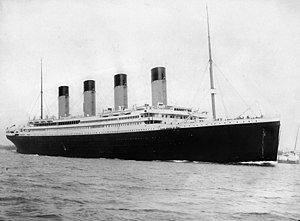RMS Titanic

RMS Titanic departing Southampton on 10 April 1912
|
|
| History | |
|---|---|
|
|
|
| Name: | RMS Titanic |
| Owner: |
|
| Port of registry: |
|
| Route: | Southampton to New York City |
| Ordered: | 17 September 1908 |
| Builder: | Harland and Wolff, Belfast |
| Cost: | 7.5 million (US dollars) |
| Yard number: | 401 |
| Laid down: | 31 March 1909 |
| Launched: | 31 May 1911 |
| Completed: | 2 April 1912 |
| Maiden voyage: | 10 April 1912 |
| In service: | 10–15 April 1912 |
| Identification: | Radio call sign "MGY" |
| Fate: | Hit an iceberg 11:40 p.m. (ship's time) 14 April 1912 on her maiden voyage and sank 2 h 40 min later |
| Status: | Wreck |
| General characteristics | |
| Class and type: | Olympic-class ocean liner |
| Tonnage: | 46,328 GRT |
| Displacement: | 52,310 tons |
| Length: | 882 ft 9 in (269.1 m) |
| Beam: | 92 ft 6 in (28.2 m) |
| Height: | 175 ft (53.3 m) (keel to top of funnels) |
| Draught: | 34 ft 7 in (10.5 m) |
| Depth: | 64 ft 6 in (19.7 m) |
| Decks: | 9 (A–G) |
| Installed power: | 24 double-ended and five single-ended boilers feeding two reciprocating steam engines for the wing propellers, and a low-pressure turbine for the centre propeller; output: 46,000 HP |
| Propulsion: | Two three-blade wing propellers and one four-blade centre propeller |
| Speed: | Cruising: 21 kn (39 km/h; 24 mph). Max: 24 kn (44 km/h; 28 mph) |
| Capacity: | Passengers: 2,435, crew: 892. Total: 3,327 (or 3,547 according to other sources) |
| Notes: | Lifeboats: 20 (sufficient for 1,178 people) |
RMS Titanic (/taɪˈtænɪk/) was a British passenger liner that sank in the North Atlantic Ocean in the early morning of 15 April 1912, after colliding with an iceberg during her maiden voyage from Southampton to New York City. Of the 2,224 passengers and crew aboard, more than 1,500 died, making it one of the deadliest commercial peacetime maritime disasters in modern history. The largest ship afloat at the time it entered service, the RMS Titanic was the second of three Olympic class ocean liners operated by the White Star Line, and was built by the Harland and Wolff shipyard in Belfast. Thomas Andrews, her architect, died in the disaster.
Under the command of Edward Smith, who went down with the ship, Titanic carried some of the wealthiest people in the world, as well as hundreds of emigrants from Great Britain and Ireland, Scandinavia and elsewhere throughout Europe seeking a new life in North America. A high-power radiotelegraph transmitter was available for sending passenger "marconigrams" and for the ship's operational use. Although Titanic had advanced safety features such as watertight compartments and remotely activated watertight doors, there were not enough lifeboats to accommodate all of those aboard due to outdated maritime safety regulations. Titanic only carried enough lifeboats for 1,178 people—slightly more than half of the number on board, and one third of her total capacity.
...
Wikipedia
